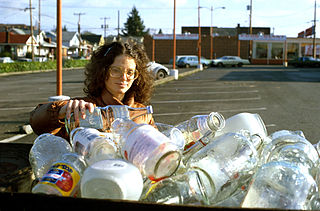Woman recycling glass in Wallingford neighborhood of Seattle, 1990. Seattle Municipal Archives/Wikimedia Commons

It’s dawn on waste-collection day in the hilly Magnolia neighborhood of Seattle. Along the curvy streets of this residential peninsula northwest of downtown, three large bins wait outside each house. The green ones hold compost — leftover food and yard clippings. The blue ones overflow with everything recyclable: glass, plastic containers, cans and aluminum foil. The round black ones, for the trash, often aren’t full these days.
Three years ago, Seattle’s City Council passed Resolution 31312, calling for zero net emissions by 2050, one of few cities crusading for this goal; along with it came a concentrated effort to push residents to conserve water, drive less and recycle way more. Half of Seattle’s greenhouse gas emissions are created through ordinary everyday life — getting around, eating and buying stuff. The city’s campaign used a gradual approach, phasing in rules like mandatory composting over three years, for example.
Seattle is one of a short list of American cities pushing for this level of effort by residents at home. Yes, early last century, some municipalities sent pigs around to eat garbage, but today, collecting food waste as a commodity is rare. There’s Portland, Oregon, and San Francisco (the first American city to require compost collections, but most cities are still working on basic recycling of paper and containers.
Seattleites I talked to said they feel proud to save resources and that doing so feels like part of the city culture — despite what might be happening or not happening in other cities — dating back to the 1980s, when Seattleites were recycling brown and green glass ahead of most of the country.
“We’re a family of five, and our garbage is rarely full,” said Kelly Hufty, who lives with her husband, David Self, and their children in Magnolia. “But our recycling is stuffed and oftentimes the yard waste and composting is full.”
Resolution 31312 called for cutting greenhouse gas emissions to 58 percent below the 2008 levels by 2030 in three areas: transportation, commercial buildings and waste. The latest report on greenhouse gas emissions from the city’s Department of Sustainability shows that those three key areas, in total, have remained the same — declined 0 percent — between 2008 and 2012, the most recent year evaluated.
However, the building and waste sectors have improved. The report shows that emissions generated by the collection of citizens’ refuse dropped 17 percent between 2008 and 2012. Building emissions are down 10 percent since 2008. Transportation emissions have increased by 6 percent since 2008 and by just 1 percent since 1990. Sustainability officials admit that the progress looks slow, but they point out that the population has increased (by 23 percent since 1990). They say that if one considers emissions reductions on a per-person basis, the progress reflects the effort citizens have been making over the past few years. Per person, emissions have decreased by 6 percent since 2008 and 22 percent since 1990.
Although the city’s stated emissions goals, though, are total emissions, it’s hard to ignore the cooperation of the individuals as they deal with their own waste. Back in 1980, the city reports, a family of three produced four 32-gallon cans of trash each week. Now that’s down to one or less than one. When the composting of food waste started three years ago, meat and dairy products were banned. Now the city takes those leftovers, too. All of the waste goes to a large composting operation run by a contractor.
The city’s statistics show that recycling is worth the trouble. One Seattle report notes that recycling had removed a net of 537,000 metric tons of carbon dioxide from the atmosphere in 2012 (in 1990, 439,000 metric tons were removed).
“It’s really great to be able to just roll that out to the curb, and away it goes — one bin — paper, plastic, metal,” says Herb Bergamini, a teacher who lives in Wallingford. He notes that the city will take labeled waste car oil too.
Hufty, who used to live in the Washington, D.C. area, says, “It’s part of living out here.”
After all, this is the city where composting toilets were installed in a famous office building, the Bullitt Center, which was designed to be carbon neutral when fully occupied. The Bullitt Center collects rainwater and makes solar power. When I visited, a staff member of Sustainable Seattle pointed me to the ladies’ room, where I could not trip the motion-sensor lights. But partly because of her attitude, I did not run back to ask for help. I fumbled for my headlamp.
Of course, even waste-savvy Seattle will not recycle many things that are part of modern American life: prescription pill bottles (the plastic is too brittle), wet or dirty produce bags, kitty litter, corks (the city does refer people to Whole Foods’ “cork reharvest” project), painted wood, treated wood, fats, cooking oils, grease. But officials are working on changing these gaps in its program. Home cooking oil could join the other curb waste in the next five years, said Timothy Croll, the city’s solid waste director. He said a separate collection of kitty litter, pet waste and diapers could start “perhaps eight years from now.”
The city now faces the challenge of motivating residents to work even harder. Mayor Ed Murray announced this year in the city’s biennial environmental report, “Moving the Needle,” that he wanted to thank Seattle residents “for all that you will do” (emphasis mine) to reduce emissions. The report soberly says that half of Seattle’s landfill-bound trash still is either food waste or recyclable. “We can do better!” the report noted.
One of the strategies of the sustainability department, which opened officially in 2000, is a poster crammed with other ideas: Don’t wash your blue jeans too often, eat less meat (sustainability officials say that meat-sellers have not complained about this), and, in this land of Microsoft, hold onto old laptop computer instead of buying new ones.
The department’s newsletter full of energy-saving tips motivates people, Hufty said. Her family doesn’t water their lawn at all now. And school programs on the new waste practices mean parents can’t get lazy. “If you try to put something in the garbage or down the disposal, you will get called on it,” Hufty said.
Still, the city’s ambitious goal will depend on the transportation piece, which accounts for 40 percent of the emissions, and while public transit funding has been in crisis, emissions from vehicles continues to rise. Building emissions have fallen, but population growth is expected to continue rising.
Can Seattle’s attitude make the difference? Geography that attracts nature lovers and the length of time Seattle has pushed for energy savings contribute to “our overall environmental savvy,” said Tracy Morgenstern, the lead advisor for climate change policy.
And as the city’s sustainability department communications advisor, Sara Wysocki, observes, “We have … a savvy population.”
About This Article
Last winter, I visited the Pacific Northwest to report on people and cliamte change. I met with the Seattle Sustainability Department and stayed with friends who live in the Magnolia neighborhood. I eventually found a home at Next City for this story about how everyday life with the trash and recycling in the city with the crunchy-granola reputation. Janine White edited this for Next City. My old friend Janine Gross of Seattle put me in touch with the residents I interviewed. Thanks to both Janines and also to Dan Stambor and Adam Stambor.
